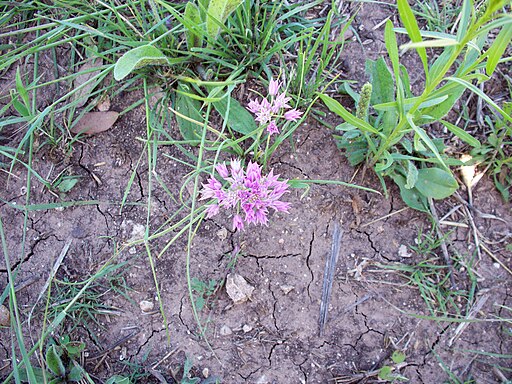Classification System: APG IV
Superregnum: Eukaryota
Regnum: Plantae
Cladus: Angiosperms
Cladus: Monocots
Ordo: Asparagales
Familia: Amaryllidaceae
Subfamilia: Allioideae
Tribus: Allieae
Genus: Allium
Subgenus: A. subg. Amerallium
Sectio: A. sect. Amerallium
Species: Allium drummondii
Name
Allium drummondii Regel, Trudy Imp. S.-Peterburgsk. Bot. Sada 3(2): 112. 1875.
Synonyms
Heterotypic
Allium nuttallii S.Watson, Proc. Amer. Acad. Arts 14: 227. 1879.
Allium reticulatum var. nuttallii (S.Watson) M.E.Jones, Contr. W. Bot. 12: 80. 1908.
Allium helleri Small, Fl. S.E. U.S.: 264. 1903.
Allium drummondii f. asexuale Ownbey, Res. Stud. State Coll. Wash. 18: 204. 1951.
Distribution
Native distribution areas:
Continental: Northern America
Regional: North-Central U.S.A.
Kansas, Nebraska, Oklahoma.
Regional: South-Central U.S.A.
New Mexico, Texas.
Regional: Southeastern U.S.A.
Arkansas.
Regional: Mexico
Mexico Northeast.
References: Brummitt, R.K. 2001. TDWG – World Geographical Scheme for Recording Plant Distributions, 2nd Edition
References
USDA, ARS, Germplasm Resources Information Network. Allium drummondii in the Germplasm Resources Information Network (GRIN), U.S. Department of Agriculture Agricultural Research Service. Accessed: 08-Apr-12.
Govaerts, R. et al. 2017. Allium drummondii in World Checklist of Selected Plant Families. The Board of Trustees of the Royal Botanic Gardens, Kew. Published online. Accessed: 2017 Sep 04. Reference page.
Vernacular names
English: Drummond's onion
Allium drummondii, also known as Drummond's onion, wild garlic and prairie onion, is a North American species of onion native to the southern Great Plains of North America. It is found in South Dakota, Kansas, Nebraska, Colorado, Oklahoma, Arkansas, Texas, New Mexico, and northeastern Mexico.[3][4]
Allium drummondii is a bulb-forming perennial. The flowers appear in April and May, in a variety of colors ranging from white to pink. It is common, considered invasive in some regions.[5][6][7]
Uses
This species of Allium is gathered by Native Americans for its small edible bulbs. These contain a considerable amount of inulin, a non-reducing sugar that humans cannot digest. Because of this, these onions must be heated for a long period of time in order to convert the inulin into digestible sugars.[8]
References
"NatureServe Explorer - Allium drummondii". NatureServe Explorer Allium drummondii. NatureServe. 2022-06-22. Retrieved 22 Jun 2022.
Regel, Eduard August von 1875. Trudy Imperatorskago S.-Peterburgskago Botaničeskago Sada 3(2): 112 in Latin
Kew World Checklist of Selected Plant Families
Lady Bird Johnson Wildflower Center, University of Texas, Allium drummondii Regel
Flora of North America Vol. 26 Page 239 Allium drummondii Regel, Trudy Imp. S.-Peterburgsk. Bot. Sada. 3: 112. 1875.
CONABIO. 2009. Catálogo taxonómico de especies de México. 1. In Capital Nat. México. CONABIO, Mexico City.
Biota of North America Program 2013 county distribution map
Bailey, L.H. & E.Z. Bailey. 1976. Hortus Third i–xiv, 1–1290. MacMillan, New York.
Retrieved from "http://en.wikipedia.org/"
All text is available under the terms of the GNU Free Documentation License


